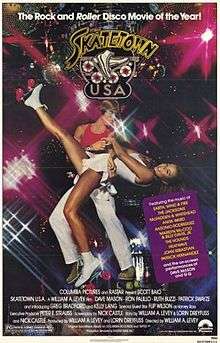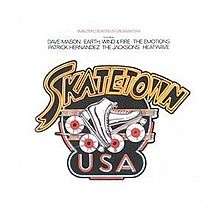Skatetown, U.S.A.
| Skatetown, U.S.A. | |
|---|---|
 Theatrical release poster | |
| Directed by | William A. Levey |
| Produced by |
Lorin Dreyfuss (producer) William A. Levey (producer) Peter E. Strauss (executive producer) |
| Written by |
Nick Castle (Screenplay & story) Lorin Dreyfuss (story) William A. Levey (story) |
| Starring |
Scott Baio Patrick Swayze Flip Wilson Maureen McCormick Katherine Kelly Lang |
| Music by |
Miles Goodman Dave Mason |
| Cinematography | Donald M. Morgan |
| Edited by | Gene Fowler Jr. |
Production company | |
| Distributed by | Columbia Pictures |
Release dates |
|
Running time | 98 minutes |
| Country | United States |
| Language | English |
| Box office | $2.35 million[1] |
Skatetown, U.S.A. is a 1979 American comedy film produced to capitalize on the short-lived fad of roller disco.[2]
The film features many TV stars from the 1960s and 1970s, among them Scott Baio, Flip Wilson, Maureen McCormick, Ron Palillo and Ruth Buzzi. Patrick Swayze's leading role as the skater "Ace" was his first movie performance. Also in the cast are Sydney Lassick, Billy Barty and Playboy centerfold model Dorothy Stratten.
Plot
One evening at a Los Angeles-area roller disco called Skatetown, U.S.A., a rivalry between two skaters (Patrick Swayze and Greg Bradford) culminates in a contest, the winning prize for which is $1000 and a moped. After a game of chicken played on motorized roller skates, the two rivals become friends.
Production notes
The setting is based on Flipper's Roller Boogie Palace, a disco roller rink which had opened in West Hollywood on Santa Monica Boulevard earlier in 1979 and was fleetingly a very popular celebrity hangout. The film includes many short, broadly comedic and slapstick subplots (such as a gag having to do with itching powder) set between long roller skating sequences and musical performances.
Filming was done mostly at the Hollywood Palladium, built in 1940. Its sprawling blond hardwood dance floor, chandeliers and soap bubbles blown by a machine from the Lawrence Welk Show can be seen in sundry scenes. Some exteriors were shot on Santa Monica Pier and at nearby Venice Beach. Patrick Swayze, who had roller skated competitively as a teenager and was a trained dancer, did his own skating and stunts in the film. April Allen, Swayze's uncredited roller-skating partner in the movie, had won the world championship in women's free skating seven years earlier.[3][4]
Twenty-nine years after filming, Maureen McCormick recalled, "Like a disco, there was a lot of cocaine being done on the set. Many people were open about it." McCormick wrote that she fell back into severe cocaine addiction during production, often showing up late for shooting or not coming to work at all.[5]
Scott Baio later recalled,
I have blocked that movie from my memory, it was so bad... That was that whole time where Xanadu and Roller Boogie and all that crap was coming out. That was one of those things where they sent me the script and I said 'no,' but they just kept calling and offering more money! I mean, they offered me a lot of money. And finally I said, 'Well, hell. What is it? Two weeks' work? Whatever. Okay. Fine.' And it was… You know, sometimes money isn’t everything. [Laughs.] It was just bad. I mean, it was bad shooting it. I’m trying to think of any real stories that I have, but it was just insanity. When was that? ’79? It was just a guy making a film who didn’t know how to make a film. And I don’t even know what the story was! Skatetown, U.S.A.? That was crapola.[6]
Cast
- Scott Baio as Richie
- Flip Wilson as Harvey Ross
- Patrick Swayze as Ace Johnson
- Maureen McCormick as Susan Nelson
- Greg Bradford as Stan Nelson
- Ron Palillo as Frankey
- Judy Landers as Teri
- Ruth Buzzi as Elvira
- Dorothy Stratten as customer at snack bar (girl who orders pizza)
- Joe E. Ross as rent-a-cop
- Dave Mason as himself
- Billy Barty as Jimmy
- Katherine Kelly Lang as Allison
- David Landsberg as Irwin
- Sydney Lassick as Murray
- Murray Langston as the drunk
- Bill Kirchenbauer as Skatetown doctor
- Denny Johnston as the wizard (club DJ)
- Vic Dunlop as Ripple
- Len Bari as Alphonse
- April Allen as Charlene (Ace's girlfriend and skating partner, uncredited)[3][4][7]
Soundtrack
| Skatetown, U.S.A. | |
|---|---|
 | |
| Soundtrack album by Various Artists | |
| Released | 1979 |
| Genre | Disco |
| Length | 39:00 |
| Label | Columbia Records |
The film features almost non-stop synchronized music, much by popular disco and pop artists from the mid and late 1970s. Most of this music is diegetic, in that it is shown within the plot as being played either through records spun by the roller disco's "wizard" DJ or performed on the club's stage and hence, is heard by both the characters and the movie's audience. Dave Mason is featured as a performer in the roller disco, playing himself. Mason sings the movie's disco-tinged theme song "Skatetown" (written by Mason and Brenda Cooper) over the opening credits. He is also shown performing "I Fell in Love" along with a cover of his own 1968 Traffic hit "Feelin' Alright." Among other songs on the soundtrack are the Patrick Hernandez dance hit "Born to Be Alive," "Boogie Wonderland" (Earth, Wind & Fire and The Emotions), "Shake Your Body" (The Jacksons), "Boogie Nights" (Heat wave), "Baby Hold On" (Eddie Money), "Ain't No Stoppin' Us Now" (McFadden & Whitehead), "I Want You to Want Me" (Cheap Trick), "Roller Girl" (John Sebastian), "Perfect Dancer" (Marilyn McCoo and Billy Davis Jr.), a cover of Mick Jagger and Keith Richards' "Under My Thumb" by the Hounds, and "Skatetown U.S.A." (John Beal) during the End Credits.
A soundtrack album was released in 1979 by Columbia Records.
Side A:
- "Skatetown" - Dave Mason (3:11)
- "Boogie Wonderland" - Earth, Wind & Fire (4:49)
- "Shake Your Body (Down to the Ground)" - The Jacksons (3:45)
- "Boogie Nights" - Heatwave (3:38)
- "Born to Be Alive" - Patrick Hernandez (3:23)
Side B:
- "Roller Girl" - John Sebastian (3:10)
- "Perfect Dancer" - Marilyn McCoo & Billy Davis Jr. (6:28)
- "I Fell in Love" - Dave Mason (2:21)
- "Under My Thumb" - Hounds (4:17)
- "Feelin' Alright" - Dave Mason (4:30)[8]
Reception
Following a widely publicized premiere party at Flipper's roller disco in West Hollywood on 1 October 1979[3][9] and billed as the Rock and Roller Disco Movie of the Year,[5] by the time of its release roller disco was a fast-waning fad and the popularity of disco music had peaked (Disco Demolition Night had already happened two and a half months earlier). Aside from some praise for Swayze's skating and screen presence[3] the movie was neither a critical nor a box office success. However, by the early 21st century a writer for oddculture.com called the film "a true cult item and one of the best 70s time capsules around. [...] There’s just something magical about a slutty Marsha [sic] eating drugged pizza with a bearded Horshack."[10]
It was later shown on cable television from time to time. There have been no known licensed VHS or DVD releases. This may be owing to home video licensing woes over the soundtrack's many major label recordings.[10][11] 35mm and 16mm full frame prints of the movie (which was shot in 35mm and cropped to widescreen for theatrical release) have been exhibited at film revivals[12] and low quality video copies made from a much faded full frame 16mm print have been in commercial circulation.[13]
References
- ↑ Richard Nowell, Blood Money: A History of the First Teen Slasher Film Cycle Continuum, 2011 p 259
- ↑ allmovie.com, Skatetown, USA, retrieved 25 September 2010
- 1 2 3 4 Swayze, Patrick and Niemi, Lisa, The Time of My Life, Simon and Schuster, 2009, pp 74-75, ISBN 978-1-4391-5858-6, retrieved 1 October 2010
- 1 2 susan-a-miller.com, Allen (Powell), April, retrieved 2 october 2010
- 1 2 McCormick, Maureen, Here's the Story: Surviving Marcia Brady and Finding My True Voice, William Morrow, pp 123-124. 14 October 2008, ISBN 978-0-06-149014-9
- ↑ Will Harris, "Scott Baio talks Chachi, Bob Loblaw, and Howard Cosell", AV Club 3 April 2014 accessed 7 April 2014
- ↑ oscars.org, Index to motion picture credits, Skatetown USA, retrieved 2 October 2010
- ↑ http://www.amazon.com/Skatetown-USA-Dave-Mason/dp/B000O0NYZE
- ↑ gettyimages.com, Premiere Party For Skatetown USA, retrieved 3 October 2010
- 1 2 oddculture.com, Roller Disco Cinema: Skatetown, U.S.A., retrieved 28 September 2010
- ↑ hanktank88.blogspot.com, Birthday Bash & Other Fun Stuff, 6 August 2010, retrieved 28 September 2010
- ↑ loc.gov, Mary Pickford Theater, Past Screenings : 2008, retrieved 28 September 2010
- ↑ brutallo.com, Cult films!, retrieved 28 September 2010
External links
- Skatetown, U.S.A. at the Internet Movie Database
- Skatetown, U.S.A. at AllMovie
- Skatetown, U.S.A. at the TCM Movie Database
- Roller Disco Cinema: Skatetown, U.S.A. at oddculture.com
- Go Go's blog page about Flipper's Roller Boogie Palace roller rink in West Hollywood